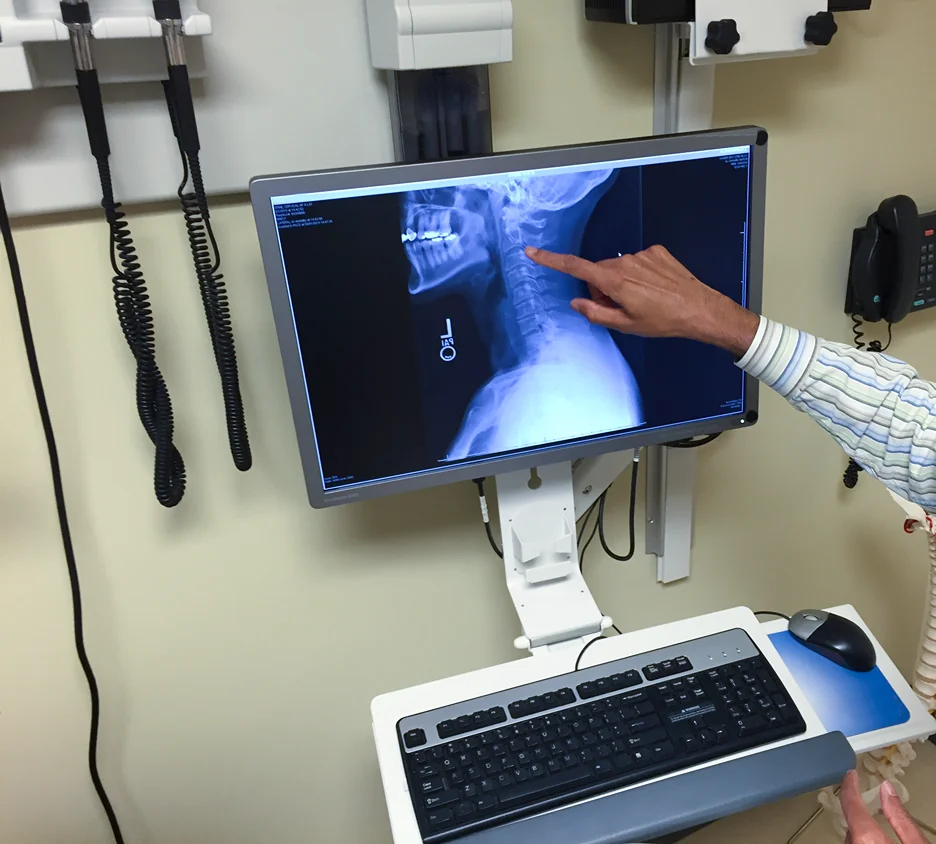Have you ever felt a sharp, tingling pain shooting down your neck and arm? Or maybe a numbness or pins and needles sensation in your hand? If so, you may be dealing with a common condition called cervical radiculopathy, more often referred to as neck nerve pain.
Neck nerve pain stems from a compressed or irritated nerve in the cervical spine region. While painful and often persistent, there are many treatment options available to help alleviate irritating nerve pain symptoms. With proper diagnosis and care, most people find effective neck nerve pain relief.
This comprehensive guide will explore the causes, symptoms, diagnosis process, and both conventional and alternative treatments for neck nerve pain.
By understanding the anatomy behind this condition, you can work with your doctor to pinpoint the source of your discomfort and establish the best path forward. Arm yourself with information to help get rid of that nagging nerve pain once and for all!
What Exactly is Neck Nerve Pain?
Neck nerve pain, also termed cervical radiculopathy, involves irritation, inflammation, or compression of the nerve roots in the cervical spine.
These spinal nerves branch out from the spinal cord and pass through small openings between the vertebrae, extending down the neck and into the shoulders, arms, and hands.
When a spinal nerve becomes compressed or inflamed, it can cause pain, numbness, and weakness along the nerve’s path. This is why neck nerve pain frequently radiates down one arm. The medical term “radiculopathy” refers to this radiating nerve pain.
Some common underlying causes of neck nerve pain include:
- Herniated discs: Discs act as cushions between the vertebrae. When a disc bulge or herniates, it can put pressure on neighboring spinal nerves. This is the most frequent cause of nerve compression.
- Bone spurs: Bony projections along the edge of the vertebrae that may press against or restrict nerves. Often due to arthritis or degenerative disc disease.
- Spinal stenosis: Narrowing of the spinal canal that houses the spinal cord and nerves. This puts pressure on the nerve roots.
- Poor posture: Bad sitting or standing posture misaligns the spine and neck, potentially compressing nerves.
- Prior injury: Past neck injuries or whiplash may have damaged nerves.
Pinpointing the cause will help determine the appropriate neck nerve pain treatment. Always consult a doctor for an accurate diagnosis.
Recognizing the Symptoms of Neck Nerve Pain
The hallmark symptom of neck nerve pain is an intense, radiating pain originating in the neck region. However, symptoms can vary significantly depending on the affected nerve and the severity of the compression.
Common symptoms include:
- Sharp, shooting pain extending from the neck down one arm
- Numbness or tingling sensations down the arm, hand or fingers
- Muscle weakness in the shoulder, arm, hand or wrist
- Burning, prickling, or electric shock-like nerve pain
- Stabbing or throbbing pain at the base of the neck
- Muscle spasms and stiffness in the neck and shoulder regions
The pain is often described as radiating, meaning it shoots along the path of the compressed nerve, rather than originating from a general location. This radiating pain serves as an important indicator for differentiating nerve pain from regular neck muscle strains.
Pay attention to any other accompanying symptoms as these provide clues for identifying the affected nerve:
- C6 nerve: Pain radiating from the neck into the shoulder and upper arm, shoulder weakness
- C7 nerve: Pain traveling into the upper arm and forearm, numbness/weakness in the forearm and hand
- C8 nerve: Pain extending into the hand, numbness/tingling of the ring and little fingers
Catching nerve irritation early not only alleviates discomfort, but can help prevent permanent nerve damage. Seek medical advice if pain persists longer than a week.
How is Neck Nerve Pain Diagnosed?

An accurate diagnosis first requires a thorough consultation with your doctor regarding symptoms and medical history. Be prepared to describe your specific pain sensations, any recent injuries, and daily habits that could contribute to nerve compression.
Your physician will conduct a physical examination, assessing your neck mobility, areas of tenderness, muscle strength and reflex responses.
If nerve pain is suspected, the following diagnostic imaging tests may be ordered to identify any spinal issues impinging on nerves:
| Test | Description |
| MRI | Uses radio waves and magnets to visualize soft tissues, ligaments, tendons and nerve roots in the neck. Can detect herniated discs, fractures, tumors or nerve impingement. |
| CT scan | Combines x-rays taken from many angles to construct cross-sectional images of bone structures in the neck vertebrae. Helps identify bone spurs, narrowing of the spinal canal, or fractures. |
| X-ray | Simple x-ray images can reveal bone changes like arthritis and fractures impacting spine alignment. |
| EMG/NCV | Measures electrical impulses along nerve fibers and muscle responses. Used to assess nerve function and pinpoint any abnormal nerve conduction. |
Conservative Treatments for Neck Nerve Pain
For mild to moderate neuropathy discomfort, doctors often first recommend trying conservative therapies focused on pain relief and improving neck mobility:
| Treatment | Description |
| Medications | Over-the-counter pain relievers and anti-inflammatory drugs to reduce swelling. Muscle relaxants may also be prescribed. |
| Cold/heat therapy | Ice packs or heating pads can alleviate nerve pain and muscle spasms in the neck. Use ice for the first 2-3 days, then switch to moist heat. |
| Cervical collar | Wearing a neck brace provides immobilization to allow nerves time to heal. Use for short periods to avoid stiffness. |
| Physical therapy | Stretching, massage, ultrasound therapy, and gentle strengthening exercises improve range of motion and blood flow. |
| Posture correction | Improving sitting and standing posture relieves pressure on compressed nerves. |
| Ergonomic adjustments | Proper setup of workstations and sleeping positions limit neck strain. |
| Steroid injections | Cortisone injected around inflamed nerves reduces swelling and irritation. |
Trying these options for 2 to 4 weeks is reasonable before considering interventional treatments. Execute appropriate lifestyle adjustments like healthy posture and regular neck stretches for lasting relief.
Interventional Procedures for Severe Nerve Pain
If conservative measures do not adequately relieve pain after 4 to 6 weeks, your doctor may suggest minimally invasive interventional procedures.
- Epidural steroid injections: Steroid medication injected into the epidural space surrounding the spinal nerves decreases inflammation pressing on nerves. Usually 2-3 injections are given.
- Nerve blocks: Local anesthetics injected into the nerves disrupt pain signals to the brain. Can determine if surgery may help.
- Radiofrequency ablation: Uses radio waves to heat up and desensitize overactive nerves causing chronic neck and arm pain. Pain relief can last up to 2 years.
- Pulsed radiofrequency: A variation of traditional ablation using pulsed bursts of radiofrequency energy as a less invasive alternative.
These targeted injections and nerve blocks aim to reduce nerve irritation and inflammation causing neuropathic pain.
When is Surgery Recommended for Neck Nerve Pain?
If arm pain persists and your quality of life remains significantly impacted after 6 to 8 weeks of conservative treatments, your physician may discuss surgery.
Common surgical procedures include:
- Cervical discectomy: Removing the portion of the herniated disc pressing on the nerve. Often done through a small incision under general anesthesia.
- Spinal fusion: Fusing together two vertebrae to restrict motion and stabilize the spine in the case of instability, arthritis, or frequent slippage of discs.
- Foraminotomy: Widening passages where nerves branch out from the spinal cord if narrowed by bone spurs.
Surgery for neck nerve pain as a last resort after exhausting nonsurgical options and is generally highly effective at relieving symptoms.
How to Manage and Improve Nerve Pain
Alongside medical treatments, you can integrate these self-care tips into your daily routine to help manage and prevent future neck nerve pain episodes:
- Maintain good posture when sitting, standing, and sleeping to take pressure off compressed nerves. Consider using a cervical pillow.
- Apply ice packs for 15 minutes to relieve acute nerve pain. Heat packs can ease muscle tension once acute pain subsides.
- Perform gentle neck stretches and exercises like chin tucks several times a day to improve range of motion.
- Adjust workstations and seating positions to limit neck strain from poor ergonomics.
- Take frequent breaks when performing repetitive neck motions and avoid hunching over screens and devices.
- Learn techniques like yoga, tai chi, and meditation to help relax tense neck muscles.
- Consider quitting smoking, as nicotine restricts blood vessels, exacerbating nerve pain.
Alternative Therapies to Supplement Treatment
In addition to mainstream medical treatments, many alternative therapies and modalities may help alleviate neck nerve pain. Always consult your physician before trying complementary options. Potential natural pain relief options include:
- Chiropractic adjustments: Spinal manipulation can improve alignment and take pressure off compressed nerves.
- Acupuncture: Insertion of thin needles into trigger points stimulates nerve pathways, blocking pain signals.
- Massage therapy: Relaxes tense neck muscles and increases blood circulation to nerves. Focus on gentle strokes rather than deep tissue work.
- Transcutaneous electrical nerve stimulation (TENS): Minimally electric pulses delivered through electrode pads modify nerve pain signal transmission.
- Low-level laser therapy: Cold laser light applied to the skin stimulates cellular energy production and reduces inflammation.
- Cervical traction: A special neck traction device gently pulls and mobilizes the spine to allow more room for nerves. Best guided by a physical therapist.
Alternative treatments show promising results for certain neck and nerve pain patients when combined with primary care.
What is the Long Term Outlook for Neck Nerve Pain?
Many mild to moderate cases of neck nerve irritation resolve within a few weeks to months with conservative treatment. However, some complications like severe herniated discs may result in chronic or recurrent pain.
Maintaining a healthy weight, proper posture, regular exercise, and neck strengthening/stretches are key to preventing flare-ups of neck nerve discomfort. Pay mind to ergonomics and avoid hunching over screens.
Quitting smoking allows for better oxygen circulation while managing stress keeps muscles relaxed. Listen to your body and avoid repetitive motions that trigger radiating neck and arm pain.
While neck nerve pain can certainly be frustrating, various effective treatment options provide hope for managing and overcoming this condition. Work closely with your healthcare providers to pinpoint the source of nerve compression and establish a personalized multi-modal pain relief and wellness plan.
The Takeaway: Seeking Proper Diagnosis and Care is Key

- Neck nerve pain, or cervical radiculopathy, results from inflammation or compression of spinal nerves in the neck region.
- Seek medical advice for radiating neck pain lasting over a week to determine underlying causes.
- Typical treatments progress from conservative care like physical therapy to interventional injections, with surgery as a last resort.
- Maintaining proper posture and neck health through exercise and stretches is vital for preventing pain recurrences.
- Alternative modalities like chiropractic, massage, and acupuncture can supplement medical treatment.
With patience and discipline in carrying out professional treatments as well as self-care, the irritation of neck nerve pain can be reduced substantially, giving back quality of life.
Neck nerve pain can be extremely debilitating and frustrating to manage. Thankfully, services like Kaly exist to connect patients with knowledgeable doctors who can provide personalized care plans for relief.
By booking a virtual visit on Kaly.com, you can easily speak with a doctor to diagnose your neck pain and get tailored treatment recommendations right from home.
